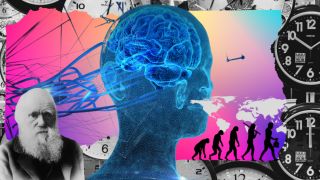Evolutionary Psychology
Neuroplasticity and Evolutionary Psychology
Exploring the potential for adaptive mechanisms.
Posted May 18, 2023 Reviewed by Gary Drevitch
Key points
- The human brain is a marvel of evolution that affords us unparalleled cognitive abilities.
- Our capacity to alter deeply ingrained evolutionary psychological processes appears to be limited.
- Neuroplasticity can play a crucial role in facilitating healthier behavioural responses.

By Corrie Jonn Block, Ph.D., DBA, and Justin James Kennedy, Ph.D., D.Prof.
For the last few years, we’ve been interested in the intersection between neuroplasticity and evolutionary psychology, focusing on the brain’s potential for altering specific evolutionary psychological adaptive mechanisms. Neuroplasticity is an amazing phenomenon that highlights the brain's incredible capacity to change and adapt. It stands in contrast to the deeply rooted nature of evolutionary psychological adaptations. It's fascinating to ponder how much our ingrained thoughts and behaviors can actually be transformed. In this exploration, we will draw upon various sources, including the influential works of David Buss, to delve into the potential of harnessing neuroplasticity to modify our evolutionary adaptations.
The human brain is a marvel of evolution, boasting a complex network of neurons that afford us unparalleled cognitive abilities. Neuroplasticity, or the brain's ability to adapt and change over time, has been a focal point of modern neuroscience, sparking interest in its potential to modify certain psychological and behavioural traits (Kolb, Gibb & Robinson, 2003). Concurrently, evolutionary psychology has sought to illuminate the psychological mechanisms honed by natural selection that underpin our biases and behaviours (Buss, 1995). The intersection of these two disciplines raises intriguing questions regarding the extent to which evolutionary psychological processes can be altered by leveraging neuroplasticity.
Fear and Anxiety Responses. Fear and anxiety, which have evolved as vital survival mechanisms (Öhman & Mineka, 2001), are deeply ingrained in our biology, particularly in the amygdala. However, research by Huberman (2020) and Sapolsky (2017) demonstrates that neuroplastic changes can play a crucial role in modifying fear and anxiety responses. Cognitive-behavioral therapy (CBT) and exposure therapy, for example, have been shown to facilitate the formation of new neural connections, empowering individuals to better manage and even reduce these responses (Hofmann, Asnaani, Vonk, Sawyer, & Fang, 2012).
Social Hierarchies and Dominance Behaviours. Evolution has ingrained a sensitivity to social hierarchies in humans, prompting behaviours that ensure survival and reproductive success. The influential work of biological anthropologist Helen Fisher delves into diverse aspects of human relationships, including attachment, adultery, divorce, and the evolutionary path and future of human family life. Fisher has found a host of personality traits linked with four brain systems associated with the brain's dopamine, testosterone, estrogen/oxytocin, and serotonin production systems (Fischer. H, 2009). However, neuroplasticity may allow alterations in how we perceive and respond to social hierarchies. Research suggests that mindfulness and meditation practices can change neural patterns, reducing dominance behaviors and increasing empathy and compassion (Lutz, Brefczynski-Lewis, Johnstone, & Davidson, 2008).
Partner Selection. Partner selection and preferences have been extensively studied in the field of evolutionary psychology. Buss (1989) conducted a seminal cross-cultural study on mate preferences, finding that certain preferences (such as men's preference for younger mates and women's preference for mates with good financial prospects) were remarkably consistent across cultures, pointing to a potential evolutionary basis. Moreover, a review by Bailey et al. (2016) found that sexual orientation, a key aspect of partner selection, appears to be largely resistant to conscious change, with attempts at conversion therapy being both unsuccessful and potentially harmful. For example, Ling (2011) documented a religious movement dedicated to leveraging the brain’s neuroplasticity to alter sexual orientation for moral reasons, suggesting that although behaviours can be influenced, sexual orientation is unlikely to be permanently alterable and attempts to do so may be damaging.
Our behaviours and preferences around mate selection are largely driven by evolutionary pressures. However, given the complex and nuanced nature of human sexual behaviour, it is unclear to what extent neuroplasticity can alter these preferences. Current research suggests that sexual preferences are likely more resilient to change, although more studies are needed to fully understand this complex interaction.
Parental Investment. Research by Geary (2000) supports the notion that parental investment strategies are deeply rooted in our biology and evolutionary history. The study highlighted sex-specific investment strategies consistent with Trivers's (1972) Parental Investment Theory, with men investing more in mate seeking and women investing more in child-rearing. These deeply entrenched behaviours are likely to be resistant to neuroplastic change due to their fundamental role in reproductive success.
Additionally, while parenting practices can change over time and vary across cultures, the fundamental patterns of investment typically align with evolutionary predictions (Quinlan, 2007). While neuroplasticity can influence behaviours related to parenting, it is unlikely to significantly alter the fundamental evolutionary adaptations related to parental investment, given their deep-rooted biological and evolutionary basis.
Aggression and Competition. Like other social behaviours, aggression and competition have evolved as adaptive responses to resource scarcity and reproductive challenges (Buss, 2019). Aggression and competition strategies are critical for survival and reproduction in many species, including humans. Buss and Shackelford (1997) found that aggression is often used as a strategy to deter rivals, prevent infidelity, and negotiate status and power. This suggests that aggression serves important survival functions and is likely a deeply ingrained evolutionary psychological process influenced by factors such as testosterone levels (Dabbs. J, et al, 1987). Fisher has made significant contributions in exploring the role of testosterone and other factors in aggression and their evolutionary significance in human societies. Despite the potential for interventions to moderate the expression of aggression, the fundamental adaptive mechanisms driving these behaviours seem to be highly resilient to change.
A Limited Toolkit
While advancements in neuroplasticity provide a powerful toolkit for modifying brain function and behaviour, our capacity to alter deeply ingrained evolutionary psychological processes appears to be limited. It seems that some adaptations, such as fear and anxiety responses and dominance behaviours, may be more amenable to change due to their proximity to conscious control and cognitive processes. However, other more fundamentally biologically driven adaptations, like sexual orientation, parental investment, aggression, and competition, may be less susceptible to intentional neuroplastic interventions due to their deep-rooted biological and evolutionary basis.
It is also important to note that while some evolutionary psychological adaptations may be resistant to change, this does not preclude the development of strategies to manage or mitigate maladaptive behaviours resulting from these adaptations. Neuroplasticity may not be able to fundamentally alter these processes, but it can still play a crucial role in facilitating healthier behavioural responses and coping strategies.
Did you know that we can actually reshape our evolutionary adaptations with some fun interventions? Group exercise, cognitive-behavioral and coaching interventions, mindfulness, neurofeedback, and a healthy dose of fun learning and even a joke can boost our brainpower with humor: For example: Why did the neuron go to looking for neuroplasticity? Because it had too many weak connections, so it trained hard to be the brain's undisputed "flex"pert! OK, sure, that's a pretty weak joke? But maybe you still smiled. Now, if you want to help rewire people's brains, just tell them some funny jokes and watch how when they ‘get it’ they find new neural connections and light up with laughter.
References
Bailey, J. M., Vasey, P. L., Diamond, L. M., Breedlove, S. M., Vilain, E., & Epprecht, M. (2016). Sexual orientation, controversy, and science. Psychological Science in the Public Interest, 17(2), 45-101.
Buss, D. M. (1989). Sex differences in human mate preferences: Evolutionary hypotheses tested in 37 cultures. Behavioral and Brain Sciences, 12(1), 1-14.
Buss, D. M. (1995). Evolutionary psychology: A new paradigm for psychological science. Psychological Inquiry, 6(1), 1-30.
Buss, D. M. (2019). Evolutionary Psychology: The New Science of the Mind (6th ed.). Routledge.
Buss, D. M., & Shackelford, T. K. (1997). From vigilance to violence: Mate retention tactics in married couples. Journal of Personality and Social Psychology, 72(2), 346-361.
Saliva testosterone and criminal violence in young adult prison inmates. Dabbs JM Jr, Frady RL, Carr TS, Besch NF. Psychosom Med. 1987 Mar-Apr;49(2):174-82. doi: 10.1097/00006842-198703000-00007. PMID: 3575604
Geary, D. C. (2000). Evolution and proximate expression of human paternal investment. Psychological Bulletin, 126(1), 55-77.
Fisher H. (2009). Why Him? Why Her? New York, NY: Henry Holt and Co; 240–243. [Google Scholar]
Huberman, A. (2020). The Neurobiology of Fear. In: Encyclopedia of Animal Cognition and Behavior, 1-11.
Hofmann, S. G., Asnaani, A., Vonk, I. J., Sawyer, A. T., & Fang, A. (2012). The Efficacy of Cognitive Behavioral Therapy: A Review of Meta-analyses. Cognitive Therapy and Research, 36(5), 427–440.
Kolb, B., Gibb, R., & Robinson, T. E. (2003). Brain plasticity and behavior. Current Directions in Psychological Science, 12(1), 1-5.
Ling, L. (2011). Pray the Gay Away? (Season 1, Episode 4). In L. Ling Our American with Lisa Ling. Oprah Winfrey Network.
Lutz, A., Brefczynski-Lewis, J., Johnstone, T., & Davidson, R. J. (2008). Regulation of the Neural Circuitry of Emotion by Compassion Meditation: Effects of Meditative Expertise. PLoS ONE, 3(3), e1897.
Öhman, A., & Mineka, S. (2001). Fears, phobias, and preparedness: Toward an evolved module of fear and fear learning. Psychological Review, 108(3), 483-522.
Sapolsky, R. M. (2017). Behave: The Biology of Humans at Our Best and Worst. Penguin Books.
Quinlan, R. J. (2007). Human parental effort and environmental risk. Proceedings of the Royal Society B: Biological Sciences, 274(1606), 121-125.
Trivers, R. L. (1972). Parental investment and sexual selection. In B. Campbell (Ed.), Sexual selection and the descent of man, 1871-1971 (pp. 136-179). Aldine.
To learn more, visit the npnHub




